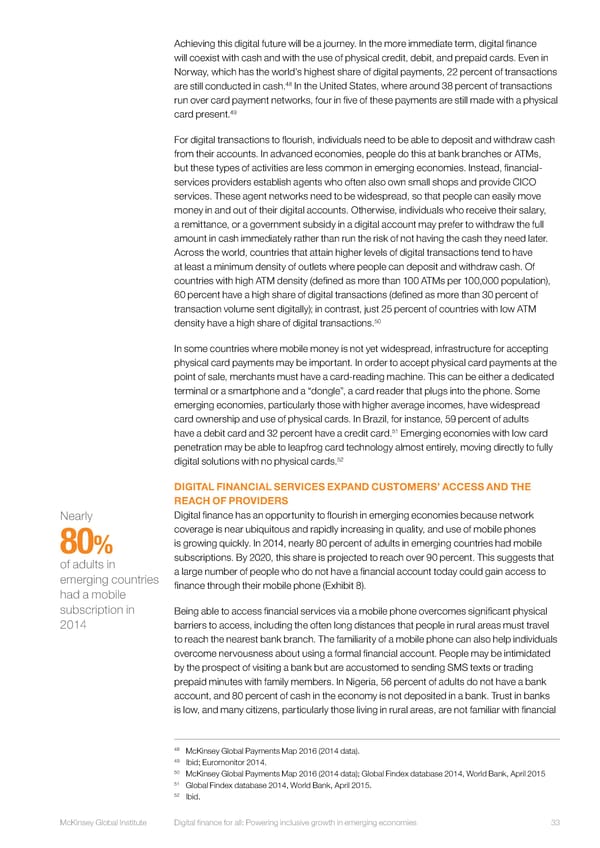Achieving this digital future will be a journey. In the more immediate term, digital finance will coexist with cash and with the use of physical credit, debit, and prepaid cards. Even in Norway, which has the world’s highest share of digital payments, 22 percent of transactions 48 are still conducted in cash. In the United States, where around 38 percent of transactions run over card payment networks, four in five of these payments are still made with a physical 49 card present. For digital transactions to flourish, individuals need to be able to deposit and withdraw cash from their accounts. In advanced economies, people do this at bank branches or ATMs, but these types of activities are less common in emerging economies. Instead, financial- services providers establish agents who often also own small shops and provide CICO services. These agent networks need to be widespread, so that people can easily move money in and out of their digital accounts. Otherwise, individuals who receive their salary, a remittance, or a government subsidy in a digital account may prefer to withdraw the full amount in cash immediately rather than run the risk of not having the cash they need later. Across the world, countries that attain higher levels of digital transactions tend to have at least a minimum density of outlets where people can deposit and withdraw cash. Of countries with high ATM density (defined as more than 100 ATMs per 100,000 population), 60 percent have a high share of digital transactions (defined as more than 30 percent of transaction volume sent digitally); in contrast, just 25 percent of countries with low ATM 50 density have a high share of digital transactions. In some countries where mobile money is not yet widespread, infrastructure for accepting physical card payments may be important. In order to accept physical card payments at the point of sale, merchants must have a card-reading machine. This can be either a dedicated terminal or a smartphone and a “dongle”, a card reader that plugs into the phone. Some emerging economies, particularly those with higher average incomes, have widespread card ownership and use of physical cards. In Brazil, for instance, 59 percent of adults 51 Emerging economies with low card have a debit card and 32 percent have a credit card. penetration may be able to leapfrog card technology almost entirely, moving directly to fully 52 digital solutions with no physical cards. DIGITAL FINANCIAL SERVICES EXPAND CUSTOMERS’ ACCESS AND THE REACH OF PROVIDERS Nearly Digital finance has an opportunity to flourish in emerging economies because network coverage is near ubiquitous and rapidly increasing in quality, and use of mobile phones 80% is growing quickly. In 2014, nearly 80 percent of adults in emerging countries had mobile of adults in subscriptions. By 2020, this share is projected to reach over 90 percent. This suggests that emerging countries a large number of people who do not have a financial account today could gain access to had a mobile finance through their mobile phone (Exhibit 8). subscription in Being able to access financial services via a mobile phone overcomes significant physical 2014 barriers to access, including the often long distances that people in rural areas must travel to reach the nearest bank branch. The familiarity of a mobile phone can also help individuals overcome nervousness about using a formal financial account. People may be intimidated by the prospect of visiting a bank but are accustomed to sending SMS texts or trading prepaid minutes with family members. In Nigeria, 56 percent of adults do not have a bank account, and 80 percent of cash in the economy is not deposited in a bank. Trust in banks is low, and many citizens, particularly those living in rural areas, are not familiar with financial 48 McKinsey Global Payments Map 2016 (2014 data). 49 Ibid; Euromonitor 2014. 50 McKinsey Global Payments Map 2016 (2014 data); Global Findex database 2014, World Bank, April 2015 51 Global Findex database 2014, World Bank, April 2015. 52 Ibid. McKinsey Global Institute Digital finance for all: Powering inclusive growth in emerging economies 33
 DIGITAL FINANCE FOR ALL Page 45 Page 47
DIGITAL FINANCE FOR ALL Page 45 Page 47